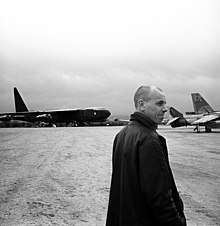Steve Pyke
Steve Pyke MBE (born 1957) is a British photographer living in New Orleans, Louisiana.[1] From 1981 to 1984, he worked for diverse publications including The Face and NME. Pyke was a staff photographer at The New Yorker from 2004 through 2010. He currently lives and works in New Orleans, Louisiana.
Steve Pyke | |
|---|---|
 Pyke in Cali, by Jonathan Worth | |
| Born | 1957 (age 62–63) Leicester, England |
| Nationality | British |
| Known for | Photography |
| Spouse(s) | Nicole Marie Kaczorowski (m. 2014) |
| Awards | MBE |
Life and career
Born in Leicester, Pyke left school at 16 to work in the local textile industry as a factory mechanic. He became involved in the turbulent music scene of the late 1970s, a move which led him into his first experiments in photography.[1] Pyke moved to London in 1978. He became a singer in a number of bands and was involved with establishing a record label and fanzines. During an extended motorcycle tour of the USA in 1976, he assembled a collection of Instamatic pictures. On his return he Xeroxed and coloured them and, fascinated by the results, purchased a Rolleiflex camera. By 1980 he had abandoned rock music for the visual arts.
Pyke's early work was sold to magazines and the music press, and exhibited from 1982. It helped to define the emergent visual signature of the iconic 1980s magazine, The Face.[2] His first cover subject was John Lydon, and Pyke's predilection for distinctive, graphically adventurous portraiture was immediately evident. He sought to develop his style by joining the Film Centre Stream course at the London College of Printing in 1982, though he was an unconventional student, working as much on his own projects as college assignments. His independent mind attracted the film director Peter Greenaway for whom Pyke created photographic works used in his films, stills and the poster shots for A Zed and Two Noughts, The Belly of an Architect, Drowning by Numbers and The Cook, the Thief, His Wife & Her Lover. More recently his work featured prominently in Mike Nichols' movie Closer.[3]
It was during an early project on film directors that Pyke established his trademark portrait style, chancing on the little close-up lenses, that when placed on his Rolleiflex camera, allowed him to make incisive, direct images within the square 6x6cm negative. The first picture made in this way, of the film director Sam Fuller in 1983, was taken the same afternoon as Pyke found the Rolleinars in an Edinburgh camera shop.[4]
Throughout his career Pyke has developed, funded and then published a number of personal projects which have given his work shape and thrust.[5] Best known perhaps are those on the world's leading thinkers (in "Philosophers")[6] and on youth identity (in "Uniforms" and "Homeless").[7] In the late nineties he completed the series, "Astronauts", photographing the men that had walked on the moon as well as related still life artefacts from the Apollo Missions.[8] Pyke has been collecting the Faces of Our Times for almost thirty years, recording those who have made a contribution to the history of the age. He has made a series on First World War veterans and The Holocaust Survivors as well as a major study of the world's leading film directors. He has produced still-life projects that include his "Soles" series and the "Post Partum Post Mortem" collection.[9][10] There is also powerful landscape work, exciting experiments in collage and multiple imagery, and a profound body of humanist street photography.
Pyke has worked for many of the world's leading magazines, and published eight books which concentrate on different aspects of his work. His work has been exhibited widely in the UK, Europe, Japan, Mexico and the USA and is held in many permanent collections, including the National Portrait Gallery, the Imperial War Museum, the V&A in London, and the New York Public Library.
Pyke was appointed an MBE in the 2004 New Year Honours list for his services to the Arts. In 2006 he was made an Honorary Fellow of the Royal Photographic Society. He became staff photographer at The New Yorker in 2004[11] and lives in New York City.
Pyke married photographer Nic Kaczorowski at St. Paul's Cathedral, London, in June 2014. They live and work in New Orleans, Louisiana with their two rhodesian ridgebacks Beauregard and Kingston.
References
- Archived 24 February 2008 at the Wayback Machine
- "National Portrait Gallery - Person - Steve Pyke". Npg.org.uk. Retrieved 12 August 2014.
- Archived 13 October 2008 at the Wayback Machine
- https://web.archive.org/web/20080224231032/http://www.pyke-eye.com/biography.html. Archived from the original on 24 February 2008. Retrieved 31 July 2008. Missing or empty
|title=(help) - Sean O'Hagan (7 January 2006). "Sean O'Hagan talks to Steve Pyke, British photographer who has taken over from Richard Avedon on the New Yorker | Art and design | The Observer". Guardian. Retrieved 12 August 2014.
- https://web.archive.org/web/20070817063510/http://www.philosophersnet.com/magazine/article.php?id=940. Archived from the original on 17 August 2007. Retrieved 30 July 2008. Missing or empty
|title=(help) - "PAGE Steve Pyke". Duckspool.com. 25 September 2007. Retrieved 12 August 2014.
- "Steve Pyke". Zonezero.com. Retrieved 12 August 2014.
- "Flowers Gallery - Homepage". Flowerseast.com. Retrieved 12 August 2014.
- Steve Pyke. "Photography guide: Steve Pyke on still life | Life and style". The Guardian. Retrieved 12 August 2014.
- Archived 17 July 2008 at the Wayback Machine